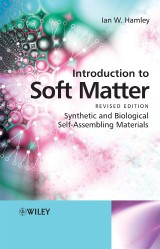Details

Introduction to Soft Matter
Synthetic and Biological Self-Assembling MaterialsRevised Edition
|
50,99 € |
|
| Verlag: | Wiley |
| Format: | EPUB |
| Veröffentl.: | 18.03.2013 |
| ISBN/EAN: | 9781118681428 |
| Sprache: | englisch |
| Anzahl Seiten: | 342 |
DRM-geschütztes eBook, Sie benötigen z.B. Adobe Digital Editions und eine Adobe ID zum Lesen.
Beschreibungen
This book provides an introduction to this exciting and relatively new subject with chapters covering natural and synthetic polymers, colloids, surfactants and liquid crystals highlighting the many and varied applications of these materials. Written by an expert in the field, this book will be an essential reference for people working in both industry and academia and will aid in understanding of this increasingly popular topic. <ul> <li> <div>Contains a new chapter on biological soft matter</div> </li> <li> <div>Newly edited and updated chapters including updated coverage of recent aspects of polymer science.</div> </li> <li> <div>Contain problems at the end of each chapter to facilitate understanding</div> </li> </ul>
Preface to the revised Edition. <p>Preface to the First Edition.</p> <p><b>1. Introduction.</b></p> <p>1.1 Introduction.</p> <p>1.2 Intermolecular Interactions.</p> <p>1.3 Structural Organization.</p> <p>1.4 Dynamics.</p> <p>1.5 Phase Transitions.</p> <p>1.6 Order Parameters.</p> <p>1.7 Scaling Laws.</p> <p>1.8 Polydispersity.</p> <p>1.9 Experimental Techniques for Investigating Soft Matter.</p> <p>1.10 Computer Simulation.</p> <p>Further Reading.</p> <p><b>2. Polymers.</b></p> <p>2.1 Introduction.</p> <p>2.2 Synthesis.</p> <p>2.3 Polymer Chain Conformation.</p> <p>2.4 Characterization.</p> <p>2.5 Polymer Solutions.</p> <p>2.6 Amorphous Polymers.</p> <p>2.7 Crystalline Polymers.</p> <p>2.8 Plastics.</p> <p>2.9 Rubber.</p> <p>2.10 Fibres.</p> <p>2.11 Polymer Blends and Block Copolymers.</p> <p>2.12 Dendrimers and Hyperbranched Polymers.</p> <p>2.13 Polyelectrolytes.</p> <p>2.14 Electronic and Opto-electronic Polymers.</p> <p>Further Reading.</p> <p>Questions.</p> <p><b>3. Colloids.</b></p> <p>3.1 Introduction.</p> <p>3.2 Types of Colloids.</p> <p>3.3 Forces Between Colloidal Particles.</p> <p>3.4 Characterization of Colloids.</p> <p>3.5 Charge Stabilization.</p> <p>3.6 Steric Stabilization.</p> <p>3.7 Effect of Polymers on Colloid Stability.</p> <p>3.8 Kinetic Properties.</p> <p>3.9 Sols.</p> <p>3.10 Gels.</p> <p>3.11 Clays.</p> <p>3.12 Foams.</p> <p>3.13 Emulsions.</p> <p>3.14 Food Colloids.</p> <p>3.15 Concentrated Colloidal Dispersions.</p> <p>Further Reading.</p> <p>Questions.</p> <p><b>4. Amphiphiles.</b></p> <p>4.1 Introduction.</p> <p>4.2 Types of Amphiphile.</p> <p>4.3 Surface Activity.</p> <p>4.4 Surfactant Monolayers and Langmuir-Blodgett Films.</p> <p>4.5 Adsorption at Solid Interfaces.</p> <p>4.6 Micellization and the Critical Micelle Concentration.</p> <p>4.7 Detergency.</p> <p>4.8 Solubilization in Micelles.</p> <p>4.9 Interfacial Curvature and Its Relationship to Molecular Structure.</p> <p>4.10 Liquid Crystal Phases at High Concentrations.</p> <p>4.11 Membranes.</p> <p>4.12 Templated Structures.</p> <p>Further Reading.</p> <p>Questions.</p> <p><b>5. Liquid Crystals.</b></p> <p>5.1 Introduction.</p> <p>5.2 Types of Liquid Crystals.</p> <p>5.3 Characteristics of Liquid Crystal Phases.</p> <p>5.4 Identification of Liquid Crystal Phases.</p> <p>5.5 Orientational Order.</p> <p>5.6 Elastic Properties.</p> <p>5.7 Phase Transitions in Liquid Crystals.</p> <p>5.8 Applications of Liquid Crystals.</p> <p>Further Reading.</p> <p>Questions.</p> <p><b>6. Biological Soft Matter.</b></p> <p>6.1 Introduction.</p> <p>6.2 Lipid Membranes.</p> <p>6.3 DNA.</p> <p>6.4 Proteins.</p> <p>6.5 Polysaccharides and Glycoproteins.</p> <p>6.6 Macromolecular Assemblies.</p> <p>Further Reading.</p> <p>Questions.</p> <p>Numerical Solutions to Questions.</p> <p>Index.</p>
"...Introduction to Soft Matter is an extremely valuable textbook for undergraduate classes, and represents an excellent introductory reading for the researchers who venture on this field." (<i>Macromol. Chem. Phys</i>. 2008, 209, 1073)
<p><strong>Ian Hamley</strong> is the Diamond Professor of Physical Chemistry at Reading University (UK). He was educated at Reading University gaining a BSc in Chemical Physics and he received his PhD at the University of Southampton in 1991. He has published many scientific papers in leading journals and his research interests include 'polymer nanotechnology, self assembly, soft materials and soft matter'. Professor Hamley has (co)written four books for Wiley (<em>Block Copolymers in Solution, Nanoscale Science and Technology<em>, <em>Developments in Block Copolymer Science and Technology</em>, and <em>Introduction to Soft Matter</em>) and one for OUP entitled <em>The Physics of Block Copolymers</em>.
Soft matter materials include polymers, colloids, emulsions, amphiphiles, surfactants, membranes, liquid crystals and biomaterials. Although these materials seem very different, they have common structural and dynamic properties that are somewhere between those of crystalline solids and simple molecular liquids and gases. Soft matter is an interdisciplinary subject drawing not only from physics, chemistry and materials science but also from biology, biochemistry and engineering. These materials have a wide range of applications, such as in structural and packaging materials, foams and adhesives, detergents and cosmetics, paints, food additives and biological materials. <p>Written in an “easy-to-follow style”, this textbook provides an introduction to this exciting subject with chapters covering natural and synthetic polymers, colloids, surfactants, biological soft matter and liquid crystals and the many and varied applications of these materials. It has been newly edited and has chapters with updated coverage of recent aspects of polymer science. A series of questions and answers is also provided at the end of each chapter. The book contains a new chapter on biological soft matter, which adds significantly to the discussion of proteins, DNA and lipid membranes in the previous edition.</p> <p>The book will appeal to students of polymer, biomaterial, colloid, surface and interface science. Experienced researchers in the field will also find this a good introductory text for revising their knowledge of the basics.</p> <p>Reviews of the First Edition</p> <p> <i>"A timely and concise textbook on "soft matter" suitable for both undergraduate students and researchers."</i></p> <p>Advanced Materials</p> <p><i>"It is well written in an easy-to-follow style and deals with some quite complex topics by good use of analogy and comparison."</i></p> <p>Chemistry in Britain</p>

















